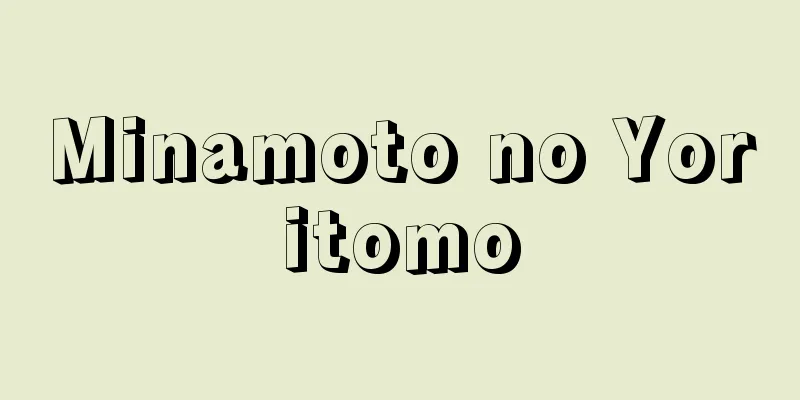Minamoto no Yoritomo

|
The first Shogun of the Kamakura Shogunate. The third son of Minamoto no Yoshitomo. His mother was the daughter of Atsuta Daigūji Fujiwara Suenori. From 1143 (Kōji 2) to 1145 (Kyūan 1), Yoshitomo managed the eastern provinces from his base in Kamakura, Sagami Province, but later went to Kyoto and married Suenori's daughter. The Atsuta Daigūji family had made an alliance with Emperor Toba and tried to maintain their influence, so Yoshitomo also played an active role as a close aide to Emperor Toba through his wife's connection, and was appointed Umagon no Kami for his military achievements in the Hōgen Rebellion (1156). In 58 (Hogen 3), at the age of 12, Yoritomo was appointed as a junior assistant to the Empress's Court. In February of the following year (Heiji 1), when Emperor Toba's daughter, Princess Michishi, became Josaimon'in, Yoritomo became Josaimon'in Kurodo, and in June, he served Emperor Nijō, the son of Emperor Goshirakawa, and was appointed as a Kurodo. In December of the same year, Fujiwara Nobuyori and Minamoto no Yoshitomo staged a coup d'état while Taira no Kiyomori was away on a pilgrimage to Kumano, and succeeded in seizing power. At that time, Yoshitomo was appointed Harima no Kami, and Yoritomo was appointed Uhyoe no Suke, Junior Fifth Rank. However, Nobuyori and his men were defeated in a battle with Kiyomori, who had returned to Kyoto, and Yoshitomo fled to the eastern provinces (Heiji Rebellion). Yoritomo tried to flee to the eastern provinces with his father, Yoshitomo, but his father was assassinated by Osada Tadamune in Owari Inland Sea, and Yoritomo was captured by Taira Munekiyo, a retainer of Taira Yorimori, in Mino and escorted to Kyoto. He was about to be executed by execution, but was spared thanks to the intercession of Kiyomori's mother-in-law, Ikeno Zenni, and was dismissed from his post and exiled to Izu. Placed under the watchful eye of the Izu nobility Ito Sukechika and Hojo Tokimasa, Yoritomo is said to have spent the next 20 years devoted to chanting sutras. However, during this time he also kept in contact with samurai from Izu and Sagami, such as Amano Tokage, Doi Sanehira, and Okazaki Yoshizane, and received information from Miyoshi Yasunobu in Kyoto, allowing him to accurately grasp the changes in the political situation between Emperor Goshirakawa and the Taira clan. It was during this time that Yoritomo married Tokimasa's daughter, Hojo Masako. In May 1180 (Jisho 4), Emperor Goshirakawa's son Prince Mochihito and Minamoto no Yorimasa raised an army under the slogan of overthrowing the Taira clan. Yoritomo received an order from Prince Mochihito and, with the support of Tokimasa and others, in August he killed Yamaki Kanetaka, a deputy governor of Izu, making his anti-Taira stance clear. When Yoritomo raised his army in Izu, the warriors of the eastern provinces rejoiced, saying, "We are filled with tears of joy, beyond words, at the news that he is reestablishing the ruins of the Minamoto clan that were cut short" (Azuma Kagami), and attacked the deputies of each province one after another. Yoritomo advanced eastward from Izu to Sagami, but was defeated by Oba Kagechika, a sectarian of the Taira clan, at the Battle of Ishibashiyama. He then fled by sea to Awa, hoping to make a comeback. Yoritomo aimed for Awa because the Miura clan, a powerful clan on the Miura Peninsula with close ties to his father, Yoshitomo, had established a powerful presence in Awa. With the help of the Awa warriors, Yoritomo quickly regained his power, and then succeeded in winning over Kazusa no Suke Hirotsune, a local government official in Kazusa, and Chiba no Suke Tsunetane, a local government official in Shimousa, to his side. Hirotsune joined Yoritomo's camp with over 20,000 cavalry. Having prepared himself, Yoritomo passed through Kazusa and Shimousa and entered Musashi, where he gained Edo Shigenaga, Kawagoe Shigeyori, Hatakeyama Shigetada and others on his side, and in October he was able to enter his ancestor's land of Kamakura. After his disastrous defeat at Ishibashiyama, Yoritomo fled to Awa and was able to recover in a short time because his policy of attacking the deputies to cut off the control and communication network of the Taira clan, guaranteeing the safety of their territories to those who participated in the uprising, and at the same time granting new lands confiscated by the enemy, perfectly matched the demands of the eastern warriors who were dissatisfied with the dictatorial rule of the Taira clan and wishing for change. The Taira clan sent Taira no Koremori to defeat Yoritomo. The two armies faced off at the Fuji River, but the Taira forces, extremely afraid of a night attack, were startled by the sound of waterfowl's wings and fled without a fight. Yoritomo tried to pursue the Taira clan to Kyoto, but listened to the advice of Miura Yoshizumi and others and gave up on his journey to Kyoto, returning to Kamakura to manage the eastern provinces. He defeated the Satake clan of Hitachi, which had shown signs of independence against Yoritomo, and then established the Samurai-dokoro (Samurai Office) as an institution to lead the samurai under his control, and appointed Wada Yoshimori as the chief (betto). At the end of the year, the new residence of the Okura (treasury) was completed, and 311 Gokenin (senior retainer) samurai nominated Yoritomo as the "Lord of Kamakura." In the leap month of 1181 (Yōwa 1), Taira no Kiyomori died of an illness. Yoritomo secretly petitioned Emperor Goshirakawa, pledging his loyalty to the Emperor and proposing the coexistence of the Genji and Taira clans. However, this proposal was rejected by the Taira clan. From that year until 1182 (Juei 1), there were severe crop failures and famines, making it impossible for either the Genji or the Taira clan to mobilize their troops. In July 1183, Minamoto no Yoshinaka pursued the Taira clan and entered Kyoto. However, Yoshinaka's lack of political power and the violence of his army drew the backlash of the Kyoto nobility, and Yoshinaka gradually came into conflict with Emperor Goshirakawa. Yoritomo did not miss this opportunity to petition again, and succeeded in winning the favor of the Emperor and the nobility. Yoritomo's imperial pardon was lifted, and he was restored to his original position of Uhyoe no Suke, Junior Fifth Rank. In October of that year, Yoshinaka's sovereignty over the eastern provinces was officially recognized (Imperial Decree of October, 2nd year of Juei). Infuriated by the secret pact between the Cloistered Emperor and Yoritomo, Yoshinaka surrounded the Cloistered Emperor's palace, Hojujidono, in November, set it on fire, captured the Cloistered Emperor, and imprisoned him in his own residence at Gojo Higashinotoin. At the same time, Minamoto no Yoshitsune, who was on his way to Kyoto under the pretext of delivering taxes from the eastern provinces to the Cloistered Emperor, was staying in Ise, but was requested by the Cloistered Emperor to enter Kyoto immediately. In January of 84 (Juei 3), Yoritomo led an army of 60,000 men, with Yoshitsune at the vanguard and Noriyori as supreme commander, to Kyoto and began an attack on Yoshinaka. After defeating Yoshinaka in Omi, the Kamakura army defeated the Taira clan, who had regained their strength and returned to Fukuhara in Settsu, at Ichinotani, and in February of the following year, 85 (Bunji 1), won a victory at Yashima, and finally cornered them at Dannoura in March, destroying them. During this time, Yoritomo was in Kamakura, and in October 84, he established the Kumonjo (Office of Official Documents) (Betto Oe Hiromoto) and the Monchujo (Butler Miyoshi Yasunobu), steadily strengthening the shogunate's system. After the fall of the Taira clan, Yoritomo was promoted to the rank of Junior Second Rank, but fearing a rapprochement between Yoshitsune and Emperor Goshirakawa, he fabricated a case of Yoshitsune's rebellion, pursued the Emperor's responsibility, and had the Emperor issue an imperial edict to pursue and kill Yoshitsune. Yoritomo sent Hojo Tokimasa and others to Kyoto, where he got the Cloistered Emperor to approve the establishment of Shugo and Jito positions as a concrete measure to prevent rebellions by warlords across the country. He also demanded that the In no Kami-no-Aide who supported Yoshitsune be dismissed and exiled, and recommended Kujo Kanezane, a supporter of Yoritomo, as an internal inspector in an attempt to curb the Cloistered Emperor's dictatorship. The establishment of Shugo and Jito positions marked an opportunity for the shogunate to extend its control to the western provinces. In 89 (Bun'ei 5), Yoritomo defeated the Oshu Fujiwara clan, who had been hiding Yoshitsune, and appointed Kasai Kiyoshige as the magistrate of Mutsu, making Mutsu and Dewa territories directly controlled by the shogunate. Thus, ten years after the start of the Genpei War, the civil war came to an end, and the shogunate's control extended across the country. In October 1190 (Kenkyu 1), Yoritomo went to Kyoto, and in November he had audiences with Emperor Goshirakawa and Emperor Gotoba, and was appointed Gon Dainagon and Ukon'e Taisho, but declined both positions and returned to Kamakura. After Emperor Goshirakawa died in March 1192, Yoritomo was finally appointed Seii Taishogun in July of the same year, thanks to the arrangement of Kujo Kanezane. After this, the shogunate awarded reward land to the vassals as a sign of its gratitude, and updated the style of documents used for appointments to Jito positions from Yoritomo's sleeve seal to Mandokoro seal. From March to May 93, Yoritomo held large-scale hunting ceremonies in Nasuno, Shimotsuke, Miharano, Shinano, and the foothills of Mt. Fuji in Suruga. These were ceremonies to ask the gods if he was qualified to rule. Over the next few years, there were a series of incidents, such as Noriyori being banished to Izu and Oba Kageyoshi being driven out of Kamakura. A serious power struggle unfolded within the shogunate, and the Hojo clan expanded its influence. In March 95 (6th year of Kenkyu), Yoritomo went to Kyoto to attend the memorial service for the reconstruction of Todaiji Temple. His visit to Kyoto with his wife and children was also intended to promote the entry of his daughter, Ohime, into the Imperial Court. However, Ohime died in 97, and the plan to enter the Imperial Court ended without being realized. At the end of 98, Yoritomo participated in a memorial service for a bridge over the Sagami River that Inage Shigenari had built for the memory of his late wife (Masako's sister). However, on the way back, he fell off his horse and died on January 13, the following year (Shoji 1), at the age of 53. The cause of his death is unknown, although there are various speculations. The Azuma Kagami, which is said to be the official daily record of the shogunate, for some reason lacks entries from 1196 to February 1199. There is no accurate record of the death of the founder of the Kamakura shogunate. Nevertheless, news of Yoritomo's death reached Kyoto quickly, and it sent a great shock to the court and the people. Fujiwara no Teika wrote, "Is this the most important matter for the court? Is this an age of fear and oppression?" (Meigetsuki, January 18, 10th year of Kenkyu). [Kazuhiko Sato] "An Introduction to Late Ancient Political History" by Ishimoda Tadashi (1956, Miraisha)" ▽ "Minamoto no Yoritomo" by Nagahara Keiji (Iwanami Shinsho)" ▽ "Medieval Japanese Society" by Nagahara Keiji (1968, Iwanami Shoten)" ▽ "Studies in Medieval Japanese Political History" by Kamiyokote Masayoshi (1970, Hanawa Shobo)" ▽ "Studies in Medieval Japanese State History" by Ishii Susumu (1970, Iwanami Shoten)" ▽ "Japanese History 9: The Kamakura Shogunate" by Oyama Kyohei (1974, Shogakukan)" ▽ "The Founding of the Kamakura Shogunate and Minamoto no Yoritomo" by Yasuda Motohisa (Kyouikusha Rekishi Shinsho) [References] | | |"Portrait of Minamoto no Yoritomo" (traditional) Copy (partial) owned by the Historiographical Institute, University of Tokyo © Historiographical Institute, University of Tokyo "> Minamoto no Yoritomo ©Shogakukan "> Minamoto no Yoritomo's signature Source: Shogakukan Encyclopedia Nipponica About Encyclopedia Nipponica Information | Legend |
|
鎌倉幕府初代将軍。源義朝(よしとも)の三男。母は熱田(あつた)大宮司藤原季範(すえのり)の女(むすめ)。義朝は1143年(康治2)から45年(久安1)ごろにかけて、相模(さがみ)国鎌倉の館(やかた)を本拠として東国経営を進めていたが、のち上洛(じょうらく)して季範の女と結ばれた。熱田大宮司家は、鳥羽(とば)法皇と結んで勢力の維持に努めていたから、義朝も妻の縁を媒介として鳥羽法皇の側近武将として活躍し、保元(ほうげん)の乱(1156)の戦功によって、右馬権頭(うまごんのかみ)に任ぜられた。58年(保元3)頼朝は12歳で皇后宮権少進(こうごうぐうのごんのしょうじん)に任官。翌59年(平治1)2月に鳥羽法皇の皇女統子が上西門院(じょうさいもんいん)となるや、上西門院蔵人(くろうど)となり、6月には後白河(ごしらかわ)上皇の皇子二条(にじょう)天皇に仕え、蔵人に補せられた。藤原信頼(のぶより)、源義朝は、同年12月、平清盛(きよもり)の熊野詣(もう)での留守をねらってクーデターを起こし、政権の奪取に成功した。このとき、義朝は播磨守(はりまのかみ)、頼朝は従(じゅ)五位下右兵衛佐(うひょうえのすけ)に叙任した。しかし信頼らは帰京した清盛との合戦に敗れ、義朝は東国へ敗走した(平治(へいじ)の乱)。頼朝は父義朝とともに東国へ逃れようとしたが、父は尾張内海(おわりうつみ)で長田忠致(おさだただむね)に謀殺され、頼朝も美濃(みの)において平頼盛(よりもり)の郎党平宗清(むねきよ)に捕らえられ、京都に護送された。まさに斬罪(ざんざい)に処せられんとするところを清盛の義母池禅尼(いけのぜんに)の口添えによって死を免れ、解官(げかん)のうえ伊豆に配流された。 伊豆の豪族伊東祐親(すけちか)、北条時政(ときまさ)の監視下に置かれた頼朝は、以後20年間にわたって読経三昧(どきょうざんまい)の日々を過ごしたとされている。しかし、この間も天野遠景(あまのとおかげ)、土肥実平(どいさねひら)、岡崎美実(おかざきよしざね)ら伊豆、相模の武士たちと連絡をもち、京都の三善康信(みよしやすのぶ)から情報を受け取るなどして、後白河上皇と平氏との間に展開する政治情況の変化を適確に把握していた。時政の女北条政子(まさこ)との結婚もこの間のことである。 1180年(治承4)5月、後白河上皇の皇子以仁王(もちひとおう)と源頼政(よりまさ)が平氏打倒をスローガンに挙兵した。以仁王の令旨(りょうじ)を受けた頼朝は、時政らの援助を得て、8月、伊豆の目代(もくだい)山木兼隆(やまきかねたか)を討って反平氏の旗幟(きし)を鮮明にした。頼朝が伊豆に挙兵すると、東国の武士たちは「源家中絶の跡を興さしめ給うの条、感涙眼(まなこ)を遮ぎり、言語の及ぶところにあらず」(吾妻鏡(あづまかがみ))と喜び、各国の目代を次々に攻撃した。頼朝は伊豆から相模へと東進したが、石橋山の戦いで平氏方の大庭景親(おおばかげちか)に敗れ、再起を期して海路安房(あわ)に逃れた。頼朝が安房を目ざしたのは、父義朝と密接な関係にあった三浦半島の豪族三浦一族が、安房に強力な勢力を扶植していたからである。頼朝は安房の武士たちの援助を得て短時日のうちに勢力を挽回(ばんかい)し、ついで上総(かずさ)の在庁官人上総介広常(かずさのすけひろつね)、下総(しもうさ)の千葉介常胤(つねたね)らを味方に引き入れることに成功した。広常は2万余騎を率いて頼朝の陣営に参加している。態勢を整えた頼朝は、上総、下総を経て武蔵(むさし)に入り、江戸重長(しげなが)、河越重頼(かわごえしげより)、畠山重忠(はたけやましげただ)らを味方に加え、10月には曩祖(のうそ)の地鎌倉に入ることができた。石橋山での惨敗ののち、安房に逃れた頼朝が短時日のうちに再起しえたのは、目代を攻撃することによって平氏の支配連絡網を切断し、挙兵参加者に所領の安堵(あんど)を保証し、あわせて敵方の没収地を新しく給与するという彼の政策が、平氏の独裁的支配に不満をもち、その変革を願っていた東国武士の要求と完全に一致したからである。 平氏は頼朝を討つために平維盛(これもり)を派遣した。両軍は富士川で対陣したが、夜襲を極度に恐れていた平氏の軍勢は、水鳥の羽音に驚いて戦わずして敗走した。頼朝は平氏を追って上洛しようとしたが、三浦義澄(よしずみ)らの忠告を聞き入れて上洛をやめ、鎌倉に帰って東国経営に努めた。頼朝に対して自立の動きを示していた常陸(ひたち)の佐竹(さたけ)氏を討滅し、ついで傘下の武士たちを統率する機関として侍所(さむらいどころ)を設置して、和田義盛(よしもり)を長官(別当(べっとう))に任命した。この年の暮れ、大蔵(おおくら)の新居が完成し、311人の御家人(ごけにん)武士は頼朝を「鎌倉の主」に推戴(すいたい)した。1181年(養和1)閏(うるう)2月、平清盛が病死した。頼朝は後白河法皇に密奏して法皇への忠誠を誓うとともに、源平の共存を申し入れた。しかし、この案は平氏によって拒絶された。この年から82年(寿永1)にかけて大凶作と飢饉(ききん)が続き、源平両方ともに兵を動かすことは不可能であった。83年7月、源義仲(よしなか)が平氏を追って入京した。しかし義仲の政治力の欠如と義仲軍の狼藉(ろうぜき)は京都貴族の反発をよび、義仲はしだいに後白河法皇と対立するに至った。頼朝はこの機を逸することなく再度奏上し、法皇と貴族の歓心を買うことに成功した。頼朝の勅勘は解かれ、もとの従五位下右兵衛佐に復した。この年10月には、東国諸国の支配権を公的に承認されている(寿永(じゅえい)2年10月宣旨)。法皇と頼朝との密約を怒った義仲は、11月法皇の御所法住寺殿(ほうじゅうじどの)を囲み、火を放って法皇を捕らえ、五条東洞院(ひがしのとういん)の自邸に幽閉した。このころ、東国の年貢を法皇に運上するという口実のもとに上洛しつつあった源義経(よしつね)は伊勢(いせ)に滞在していたが、法皇から即刻の入京を要請された。84年(寿永3)正月、頼朝は義経を先陣とし、範頼(のりより)を総大将に任命して6万の大軍を京都に進め、義仲攻撃を開始した。義仲を近江(おうみ)に討滅した鎌倉軍は、勢力を回復して摂津(せっつ)福原に戻っていた平氏を一ノ谷で破り、翌85年(文治1)2月には屋島で勝利し、ついに3月には壇ノ浦へと追い詰め、これを滅亡させた。この間頼朝は鎌倉にあって、84年10月には公文所(くもんじょ)(別当大江広元(おおえのひろもと))と問注所(もんちゅうじょ)(執事三善康信)を設置し、幕府の体制を着々と強化していった。平氏滅亡後、頼朝は従二位に叙せられたが、義経と後白河法皇との接近を恐れて義経謀反事件を捏造(ねつぞう)し、法皇の責任を追及するとともに、義経追討の院宣(いんぜん)を出させるに至った。頼朝は北条時政らを上洛させ、全国武将たちの反乱防止の具体策として守護(しゅご)・地頭(じとう)の設置を法皇に承認させるとともに、さらに親義経派の院近臣の解官・配流を要求し、頼朝派の九条兼実(くじょうかねざね)を内覧に推挙して、法皇独裁を抑止しようとした。守護・地頭の設置は、幕府の支配権を西国にまで及ぼす契機となった。89年(文治5)頼朝は、義経をかくまっていた奥州藤原氏を討ち、葛西清重(かさいきよしげ)を陸奥(むつ)の奉行(ぶぎょう)に命じ、陸奥、出羽(でわ)を幕府の直轄領とした。こうして源平争乱の開始以来10年にして内乱は終息し、幕府の支配権は全国に及ぶこととなった。 1190年(建久1)10月頼朝は上洛し、11月には後白河法皇、後鳥羽(ごとば)天皇に謁見、権大納言(ごんだいなごん)、右近衛(うこんえ)大将に任命されたが、両職を辞退し鎌倉に帰った。92年3月後白河法皇が没すると、九条兼実の計らいによって同年7月に頼朝はついに征夷(せいい)大将軍に補任された。これ以後幕府は、恩沢の沙汰(さた)として御家人たちに恩賞地を与え、地頭職補任などの際に使用する文書の様式を頼朝袖判(そではん)の下文(くだしぶみ)から、政所(まんどころ)下文に更新していった。93年3月から5月にかけて、頼朝は下野那須野(しもつけなすの)、信濃(しなの)三原野、駿河(するが)の富士裾野(すその)などで大規模な巻狩(まきがり)を行っている。統治者としての資格を神に問うための儀式であった。これから数年の間、範頼が伊豆に流されたり、大庭景義(かげよし)が鎌倉を追われるなどの事件が続いた。幕府内で深刻な権力闘争が展開し、北条氏が勢力を伸張させていったのである。95年(建久6)3月、頼朝は東大寺再建供養に臨むため上洛した。妻子を伴っての上洛は、女の大姫(おおひめ)の入内(じゅだい)工作を促進するという目的をももっていた。しかし97年に大姫が死去したことにより、入内の計画は実現することなく終わってしまった。98年の暮れ、頼朝は、稲毛重成(いなげしげなり)が亡妻(政子の妹)の追福のために新造した相模川の橋供養に参加。しかしその帰途に落馬し、翌99年(正治1)正月13日、53歳で死去。死因は、さまざまに憶測されているが不明である。幕府の公式な日録であるといわれる『吾妻鏡』は、なぜか1196年から99年2月までの記述を欠落させている。鎌倉幕府の創設者の死を正確に伝える記録はない。とはいえ、頼朝の死はいち早く京都に伝えられ、朝野に大きな衝撃を与えた。藤原定家(ていか)は、「朝家の大事、何事かこれに過ぎんや、怖畏逼迫(ふいひっぱく)の世か」(『明月記』建久10年1月18日)と記している。 [佐藤和彦] 『石母田正著『古代末期政治史序説』(1956・未来社)』▽『永原慶二著『源頼朝』(岩波新書)』▽『永原慶二著『日本の中世社会』(1968・岩波書店)』▽『上横手雅敬著『日本中世政治史研究』(1970・塙書房)』▽『石井進著『日本中世国家史の研究』(1970・岩波書店)』▽『大山喬平著『日本の歴史9 鎌倉幕府』(1974・小学館)』▽『安田元久著『鎌倉開府と源頼朝』(教育社歴史新書)』 [参照項目] | | |「源頼朝画像」(伝) 東京大学史料編纂所所蔵模写(部分)©東京大学史料編纂所"> 源頼朝 ©Shogakukan"> 源頼朝花押 出典 小学館 日本大百科全書(ニッポニカ)日本大百科全書(ニッポニカ)について 情報 | 凡例 |
Recommend
Myofibril - muscle fibril
The myofibrils are the building blocks of muscle m...
Referendum
Referendum is a system in which the people directl...
Compulsory referendum - Compulsory referendum
… [Three types] In a referendum system, after the...
Official Garden
... Gardens were also used as community squares w...
Signs - Encho
…However, all countries, which had no choice but ...
Izumi - Izumi
…It is widely distributed from central Honshu sou...
Silver orchid - Silver orchid
A perennial plant of the orchid family (APG class...
Brouwer, Hendrick
[Born] 1581.4. Died: August 7, 1643. Chief of the ...
management training program
...The first period was the introduction of Ameri...
Ichikawa Danjuro (10th generation)
...The name Soshian was given to him by Fujitani ...
Ito Official - Ito Official
For a bounded f where all functions are bounded c...
Tischbein, JFA (English spelling) TischbeinJFA
...There were more than 20 painters in this famil...
Bias (Legend) (English spelling) Bias
…His name means “black foot”. After saving his li...
Gold and silver inflow and outflow
...A general term for lawsuits related to monetar...
Yasugibushi - Yasugibushi
A folk song from the Yasugi region of Shimane Pre...









